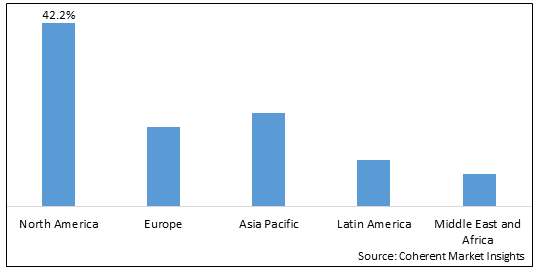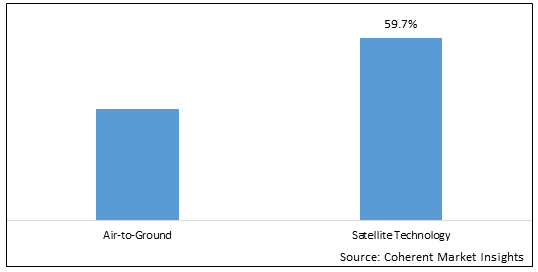In-Flight Wi-Fi Market is estimated to be valued at USD 10.5 Bn in 2025 and is expected to reach USD 22.92 Bn in 2032, exhibiting a compound annual growth rate (CAGR) of 11.8% from 2025 to 2032.
Wi-Fi is the family of wireless networking technologies that are commonly used for local area networking of devices and internet access. Wi-Fi technology enables wireless connectivity on radio frequencies between 2.4 GHz and 5 GHz. Wi-Fi technology is being increasingly deployed in enterprises and the transportation sector, thus replacing wired LAN (Local area network) at a rapid pace. This technology enhances passenger experience, enabling real-time communication, entertainment streaming, and remote work. Furthermore, Wi-Fi has been incorporated in aviation to provide In-Flight entertainment to aircraft passengers during a flight.
Global In-Flight Wi-Fi Market - Regional Analysis
Figure 1. Global In-Flight Wi-Fi Market Share (%), By Region, 2025

To learn more about this report, Download Free Sample
In North America, the In-Flight Wi-Fi market dominates and continues to thrive due to the widespread adoption of connected devices and the demand for seamless inflight connectivity. Major airlines invest heavily in advanced technologies, offering high-speed Wi-Fi and enhanced entertainment options to cater to passengers' expectations. The competitive landscape fosters innovation, with companies striving to improve coverage and bandwidth. Regulatory support and a tech-savvy population further drive the market growth.
Europe's In-Flight Wi-Fi market experiences steady expansion as airlines prioritize passenger comfort and engagement. With the region's dense air traffic, reliable inflight connectivity is crucial. European airlines collaborate with technology providers to offer reliable internet services, enhancing the overall travel experience. Despite challenges in maintaining coverage over remote areas, the market benefits from the growing popularity of connected services and entertainment options among travelers.
The Asia Pacific In-Flight Wi-Fi market witnesses rapid growth fueled by the region's increasing air travel rates and the integration of technology into daily life. Asian airlines adopt innovative connectivity solutions to accommodate passengers' connectivity needs. However, challenges arise due to diverse geographical landscapes and regulatory variations across countries. The market's potential remains immense as key players invest in infrastructure and partnerships to deliver consistent and high-quality inflight Wi-Fi services.
Global In-Flight Wi-Fi Market - Segmentation by Technology
Figure 2. Global In-Flight Wi-Fi Market Share (%), by Technology, 2025

To learn more about this report, Download Free Sample
Satellite technology dominates the In-Flight Wi-Fi landscape, offering global coverage and reliable connectivity, even over remote areas. It can be further categorized into bands, such as Ka-Band and Ku-Band, each offering specific advantages in terms of bandwidth and capacity.
Moreover, on August 2022, Viasat Inc. an innovator and provider of satellite communication products and servicesrevealed its plan to deploy its high-performance Ka-band In-flight Connectivity (IFC) system on Airshare's upcoming Bombardier Challenger 350 aircraft deliveries, as well as on the subsequent Challenger 3500 deliveries commencing in the coming years. The initial installation on Airshare Challenger 350 was successfully accomplished in July 2022, and further installations are scheduled to take place throughout the latter half of 2022
In-Flight Wi-Fi Market Report Coverage
| Report Coverage | Details | ||
|---|---|---|---|
| Base Year: | 2024 | Market Size in 2025: | USD 10.5 Bn |
| Historical Data for: | 2020 To 2024 | Forecast Period: | 2025 To 2032 |
| Forecast Period 2025 to 2032 CAGR: | 11.8% | 2032 Value Projection: | USD 22.92 Bn |
| Geographies covered: |
|
||
| Segments covered: |
|
||
| Companies covered: |
Gogo Inc., EchoStar Corporation, Global Eagle Entertainment Inc., Kymeta Corporation, ViaSat Inc., Thinkom Solutions Inc., Thales Group, Honeywell International Inc., SITA, and Panasonic Corporation |
||
| Growth Drivers: |
|
||
| Restraints & Challenges: |
|
||
Uncover macros and micros vetted on 75+ parameters: Get instant access to report
Global In-Flight Wi-Fi Market - Key Competitors
The key industry participants in the global in-flight Wi-Fi market are Gogo Inc., EchoStar Corporation, Global Eagle Entertainment Inc., Kymeta Corporation, ViaSat Inc., Thinkom Solutions Inc., Thales Group, Honeywell International Inc., SITA, and Panasonic Corporation.
Global In-Flight Wi-Fi Market - Recent Developments
Global In-Flight Wi-Fi Market - Drivers
Technological advancements
Continuous advancements in satellite and communication technologies are revolutionizing In-Flight Wi-Fi systems. Innovations are boosting their capacity, speed, and coverage, significantly improving the quality of passengers' connectivity experiences. State-of-the-art satellites enable broader coverage, even over remote areas, while upgraded communication protocols enhance data transmission speeds. This allows travelers to enjoy seamless streaming, real-time communication, and productive work during flights. These technological strides not only enhance the convenience for passengers but also cater to the increasing demand for reliable and high-speed connectivity, driving the evolution of the global In-Flight Wi-Fi market towards a more connected and engaging travel experience.
Meeting evolving digital connectivity demands
The surge in connected devices and the integration of digital technologies into daily life have significantly elevated passenger expectations regarding In-Flight Wi-Fi services. Modern travelers, accustomed to seamless connectivity on the ground, now anticipate the same level of reliability and high-speed internet access during air travel. This evolving demand has prompted airlines to prioritize the enhancement of their In-Flight connectivity solutions. To meet these expectations, airlines are investing in advanced technologies that deliver faster and more consistent Wi-Fi experiences, offering passengers the ability to stay connected, work, communicate, and access entertainment seamlessly while in the air. This shift underscores the need for continuous improvements in the In-Flight Wi-Fi landscape to align with passengers' evolving digital lifestyles.
Global In-Flight Wi-Fi Market - Restraints
High initial costs and investments
Introducing In-Flight Wi-Fi necessitates substantial initial investments for hardware, setup, and upkeep. Airlines must carefully balance these costs with anticipated income streams and passenger interest. Weighing the potential benefits of enhanced passenger experience, competitive edge, and potential ancillary revenue against the financial outlay poses a critical challenge. This delicate equilibrium shapes airlines' decisions on whether to adopt In-Flight Wi-Fi and the extent to which they invest in providing seamless connectivity services at 30,000 feet.
Counterbalance - While the implementation of In-Flight Wi-Fi indeed demands considerable upfront expenditures, airlines also recognize the value it brings. In-Flight Wi-Fi can enhance passenger satisfaction, enabling productive work, entertainment, and communication during flights. This positive experience can translate into increased customer loyalty and repeat business. Moreover, airlines can explore additional revenue streams through paid Wi-Fi plans and partnerships with content providers. By weighing these potential benefits against the initial investment, airlines can make informed decisions about the level of In-Flight Wi-Fi service they wish to offer and its long-term viability.
Global In-Flight Wi-Fi Market - Opportunity
Increasing demand for connectivity
The escalating dependence on digital devices coupled with the imperative of constant connectivity has amplified passenger expectations for In-Flight Wi-Fi services, facilitating productivity and entertainment during air travel. Airlines are positioned to address this burgeoning demand by provisioning steadfast and high-velocity connectivity. The provision of such reliable In-Flight Wi-Fi not only meets passengers' evolving preferences but also causes a competitive advantage for airlines that are keen on enhancing their service quality and passenger satisfaction quotient. This strategic response aligns with the contemporary traveler's requisites and affords airlines the prospect of augmenting their market standing.
Moreover, on March 2, 2020, the central government of India permitted airlines operating in India to provide In-Flight Wi-Fi services to passengers.
Increasing adoption of partnerships and collaborations among airlines and technology entities
Airlines and technology entities are presented with a strategic opening to forge collaborative alliances, fostering advancements in the realm of In-Flight connectivity. By engaging in partnerships with satellite operators, technology corporations, and content providers, airlines can engender an elevated In-Flight experience. Such collaborations can yield refined services and a more extensive array of offerings, effectively meeting the diverse preferences of passengers. These synergistic ventures can result in the amalgamation of specialized expertise, propelling innovation and positioning the involved parties at the forefront of delivering heightened connectivity solutions within the aviation domain.
For instance, in November 2022, AirAsia India, a Malaysian multinational low-cost airline collaborated with cloud technology firm, Sugarbox to provide In-Flight Wi-Fi service on all its aircraft. Travelers on AirAsia India flights will be able to access over 1,000 international and Indian movies, short films, web series episodes, and stream buffer-free content from OTT (over-the-top) apps via the system installed in the aircraft.
Global In-Flight Wi-Fi Market - Impact of COVID-19
The aviation sector bore a substantial brunt from COVID-19, witnessing declines in global flights, both international and domestic, consequently influencing the desire for In-Flight Wi-Fi solutions. Nevertheless, with the gradual easing of lockdown measures and the subsequent rise in flight operations and passenger volumes, the demand for inflight Wi-Fi services exhibited a resurgent trend.
*Definition: In-Flight Wi-Fi refers to the provision of wireless internet connectivity aboard aircraft during flight operations. It encompasses the deployment of satellite-based or terrestrial communication systems to enable passengers and sometimes crew members to access the internet, exchange data, and engage in online activities using their personal electronic devices while airborne. This service seeks to bridge the connectivity gap that traditionally exists during flights, allowing passengers to remain digitally engaged and facilitating activities such as communication, entertainment consumption, and business-related tasks throughout the duration of their journey.
Share
Share
About Author
Suraj Bhanudas Jagtap is a seasoned Senior Management Consultant with over 7 years of experience. He has served Fortune 500 companies and startups, helping clients with cross broader expansion and market entry access strategies. He has played significant role in offering strategic viewpoints and actionable insights for various client’s projects including demand analysis, and competitive analysis, identifying right channel partner among others.
Missing comfort of reading report in your local language? Find your preferred language :
Transform your Strategy with Exclusive Trending Reports :
Frequently Asked Questions
Select a License Type
Joining thousands of companies around the world committed to making the Excellent Business Solutions.
View All Our Clients